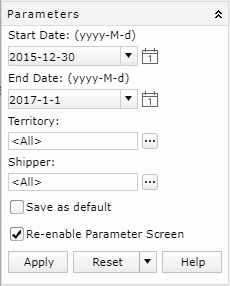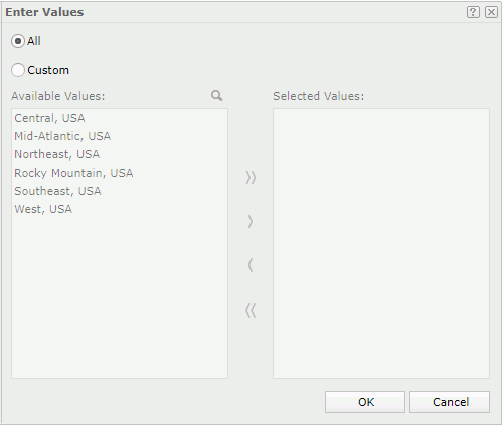Applying Parameters
When running a web report with parameters, a dialog is displayed for you to specify the parameter values. The runtime parameter dynamically controls your report result. After the report is opened in Web Report Studio, you can change the parameter values in the Parameters panel. You can also use parameter control or parameter form control to change the parameter values for the report.
The Parameters panel is available when the current web report uses parameters. It lists all the parameters used by the report.

Edit the values according to your requirement and then select Apply to make the report run with the specified parameter values.
The way to specify a parameter value varies according to the type and properties of the parameter. Here are several ways you can use to specify parameter values:
- In the parameter value combo box, select the required one from the drop-down list or input the value manually.
When a parameter's values are encrypted, the value drop-down list will be disabled. In this case, if the Hide Parameter Value checkbox is available, you can uncheck it to enable the drop-down list to view and select the required value.
- Select or unselect the checkbox to specify a Yes/No value.
- Select the button
 to specify multiple values if the parameter allows for multiple values.
to specify multiple values if the parameter allows for multiple values. - Select the calendar button
 to specify a date and time value.
to specify a date and time value.
Note: You are recommended not to use blank as the thousands separator in Number-typed parameter values under French locale, otherwise your input will not be correctly recognized because of a JVM bug. For details, see http://bugs.sun.com/view_bug.do;jsessionid=c8cdaf911b20fffffffffd9fc6340b30d670?bug_id=4510618.
Tip: Administrators can limit the number of values shown in the value list of the parameters that are bound with columns by setting the Max Records in Parameter Value List option in the Administration > Configuration > Advanced page in the server console.
Below shows the usages about the other options in the panel:
- Save as default
Saves current parameter values as the default values for the report. Not available when Enable Setting Default Parameter Values For Web Report the corresponding report type is unchecked in the server profile. - Re-enable Parameter Screen
When this option is unselected, the next time the report runs via operation in the Logi JReport Server console, it will use the default parameter values directly without popping up the Enter Parameter Values dialog. However, if the default values cannot completely match the report parameters, the dialog will still be displayed. You can check it to show the Enter Parameter Values dialog again after it has been hidden.This option is not available when Enable Hiding Initial Parameter Dialog For Web Report is unchecked in the server profile.
The Save as default and Re-enable Parameter Screen options are user-report level settings, that is to say, they take effect when both the same user and report are matched. This also applies to admin users, and therefore admin users cannot customize the settings for all users.
- Reset
Resets the parameter values. This button varies according to different situations:- When Save as default is available in the panel, the button contains a text part and a triangle icon. You can choose to reset the values to either of the following by selecting the triangle. If you select the text part of the button directly, the values will be reset to the original default values.
- Original Default Values
The default values defined in the parameters' definition. - User-Defined Default Values
Your last-time saved default values.
- Original Default Values
- When Save as default is unavailable in the panel, the button contains only the text part. Selecting it will reset the values to the original default values.
- When Save as default is available in the panel, the button contains a text part and a triangle icon. You can choose to reset the values to either of the following by selecting the triangle. If you select the text part of the button directly, the values will be reset to the original default values.
Specifying Multiple Values for a Parameter
For a parameter that allows for multiple values (the parameter's Allow Multiple Values property is true), you can specify one or more values to it.
- Select
 in the value text box of the parameter. The Enter Values dialog appears.
in the value text box of the parameter. The Enter Values dialog appears.

- If the parameter's Enable the "All" Option property is true, the All checkbox is available and by default it is selected. It means to apply the "All" value to the parameter. When the parameter is inserted as a field into a report and All is selected as the value, the field will show the string "All". If you do not want to apply the "All" value to the parameter, deselect the All checkbox, then check the Custom option and specify the desired values as shown in the following steps.
- Select the required values in the Available Values box and select
 to add them to the Selected Values box; to add all the available values, select
to add them to the Selected Values box; to add all the available values, select  . You can make use of the Search button
. You can make use of the Search button  to search for the required values among the available values: select the
to search for the required values among the available values: select the  button to display the search text box, type in the keyword
and the available values that contain the keyword will be listed with the keyword highlighted in the values.
button to display the search text box, type in the keyword
and the available values that contain the keyword will be listed with the keyword highlighted in the values.
If some added values are not wanted, select them in the Selected Values box and select
 to remove them; to remove all added values, select
to remove them; to remove all added values, select  .
. - When the parameter's Allow Type-in of Value property is true, you can add values for the parameter manually: select the button
 , type in a value in the displayed text box, then press Enter to add it to the Selected Values box. When the parameter is bound with a column, but the display column is different from the bound column, make sure the value you enter is that of the bound column. After finishing adding the values manually, select
, type in a value in the displayed text box, then press Enter to add it to the Selected Values box. When the parameter is bound with a column, but the display column is different from the bound column, make sure the value you enter is that of the bound column. After finishing adding the values manually, select  in the text box to close it. If the parameter is of the Date, Time or DateTime type, you can also select the calendar button
in the text box to close it. If the parameter is of the Date, Time or DateTime type, you can also select the calendar button  to specify a date and time value.
to specify a date and time value.
- Select OK to select the specified values for the parameter.
 Previous Topic
Previous Topic